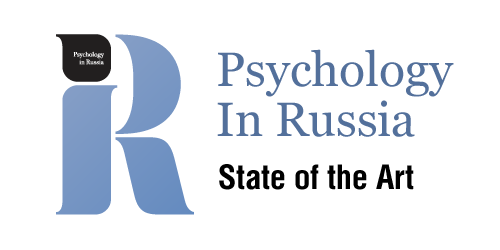Moscow University Psychology Bulletin. Series 14. Psychology, 2014, 2, 136 p.
Moscow University Psychology Bulletin. Series 14. Psychology, 2014, 2, 136 p.
Zinchenko Yu. P., Evdokimov V. I., Rybnikov V. Yu.(2014). Аnalysis of Russian and foreign dissertations in the field of medical (clinical) psychology (1990–2011) . The Moscow University Psychology Bulletin, 2, 3-15
The article provides the analysis of 766 dissertations on specialization 19.00.04 “Medical psychology” submitted to dissertational councils in the Russian Federation and 23 807 foreign doctoral theses in the field of clinical psychology presented in ProQuest Dissertations & Theses Database in 1990–2011. Compared to the international flow, the Russian array of theses includes less research (p<0.001) in history and methodology of medical psychology, psychological interventions, psychological aspects of medical treatment, psychological hygiene and prevention, social rehabilitation and improvement of patients’ quality of life and more research (p<0.001) in pathopsychology, neuropsychology, psychosomatics and somatic psychology, psychology of developmental impairments and deviant behavior. Quantitative and dynamic characteristics of dissertation flow on specialization 19.00.04 “Medical psychology” revealed strong links with macroeconomic development, indicator of scientific potential and innovative researchers’ activity in the field of medical (clinical) psychology in Russia.
Received: 02/03/2014
Pages: 3-15
Keywords: thesis;
medical (clinical) psychology;
dissertation flow;
professional preparation of highly qualified specialists;
innovations;
sociology of science;
Available Online: 30.06.2014
Empirical studies
Kuznetsova A. S., Luzyanina M. S.(2014). Psychological problems of rest planning and rest arrangement: Proactive or reactive approach . The Moscow University Psychology Bulletin, 2, 16-30
The empirical study is targeted to estimate the subjective value of rest and to analyze rest as an activity for efficient recovery. The study was conducted in employees of different industrial and service organizations. The results showed that mostly by all respondents rest is accepted as an important instrumental value for workability maintenance. At the same time, high rating positions of rest in the life values list does not always transform rest value into the intention to arrange recreation purposively. The type of attitudes to rest determines different approaches to rest arrangement: proactive (based on anticipative rest planning) or reactive (which manifest itself in acceptance of rest as necessary recreation combined with no special rest arrangements). The extraction of indirect rest attributes seems to be possible on the base of psychosemantic analysis of the notions form work and rest domains. The semantic distance evaluation of the work and rest notions allows revealing different meanings of recreation: as a forced necessity because of work and for work, or as a possibility for recovery.
Received: 03/17/2014
Pages: 16-30
Keywords: rest;
work;
recreation;
recovery;
rest as an instrumental value;
proactive and reactive attitudes to res;
psychosemantic analysis;
Available Online: 30.06.2014
Matyushkina A. A., Zhukovskaya E. K.(2014). The conditions for actualization of intuition in creative problem solving . The Moscow University Psychology Bulletin, 2, 31-45
The article presents an empirical study of the conditions for actualization of intuition in creative problem solving. Intuition is considered (in the context of the theory of problem situations) as a special form of a preliminary understanding of sense of the problem situation (creative problem), providing opportunities for further prognosis of solution. The special material of this study — fragments of artistic films of different genres. Subjects were required after viewing a short fragment of the film to guess the finish of the film as a whole. The study shows that significant conditions for actualization of intuition in solving this type of problem tasks are: the stability of interest to the solution, the type of prompt (genre, accidental prompt), intellectual and personal possibilities of the subject (“depth” of thinking; “semantic potential” — similar to the problem an emotional experience).
Received: 02/03/2014
Pages: 31-45
Keywords: creative thinking;
creative problem;
creative problem solving;
intuition;
the conditions for actualization of intuition;
prompt;
Available Online: 30.06.2014
Nourkova V. V., Bodunov E. A.(2014). Autobiographical memory as a resource for coping with intrapersonal conflict in alcoholics . The Moscow University Psychology Bulletin, 2, 46-60
This paper presents empirical study supporting the hypothesis that autobiographical memory may serve as a compensation resource for destructive transformation of self-identity in terms of intrapersonal conflict in alcoholism. 51 non-amnestic alcoholics abstinent from alcohol participated in the study.Participants got a standard piece of paper with a horizontal arrow line on it with instruction to consider this line as it was representing the entire lives (Life Line), to locate the most important and memorable events around the timeline, to date the events and to indicate valance and intensity of emotion associated with each recalled event by distance from the arrow top (positive) to its bottom (negative). Three findings relevant to the goal of achievement an acceptable level of self-confidence by transformation of autobiographical memory were identified. First, there was 30% increase number of events on Life Line in comparison to healthy controls (n=92). We explained the result as compensatory mechanism balancing negative experiences of being alcoholic by positive memories to maintain positivity index close to controls. Second, there was a shift of memories to the left part of Life Line. That means that alcoholics both started and finished their Life Lines from earlier memories than controls. We refer this finding to attempt to keep a normal subjective duration of event filled part of past. Third, we found that in alcoholics there was no reminiscence bump in time distribution of memories. In our opinion, it reflects the fact of incomplete acquisition of cultural life script structure.
Received: 02/19/2014
Pages: 46-60
Keywords: autobiographical memory;
personality;
memory plasticity;
Life Line method;
alcoholism;
motivational distortion;
Available Online: 30.06.2014
Korneev A.A., Kurgansky A.V.(2014). Change in order of movements constituting in series set by visual template. The Moscow University Psychology Bulletin, 2, 61-74
Whenever the reverse order of delayed execution of sequence of movements set by a visual template is required, the question arises as to how the sequence representation is stored in working memory (WM). One option is to first reverse the order of movements and then retain the result in WM. The other option is to retain the original order of elements and change it immediately before or during the sequence execution. In order to verify which of the two options takes place we conducted an experiment in which 14 adult (20—30 years old) subjects were asked to memorize the route of visual cursor moving along the invisible polygonal chains and after a given delay to reproduce the motion with a graphical tablet in either direct or reverse order. The analyses of latency and timing for the sequences produced in either direct or reverse order showed that the order reversal does not affect the latency but results in some increase of the time spent (pause) in the vertices of piecewise trajectories. It also shown that the order reversal effect neither spatial characteristics of the reproduced sequences nor the frequency of the erroneous reproduction. The reported results suggest that the reversal of the order of elements in a sequence of movements occurs during the sequence execution
Received: 02/07/2014
Pages: 61-74
Keywords: working memory;
latency;
internal representation;
serial order;
sensory memory;
Available Online: 30.06.2014
Abramova A.A., Kuznetsova S.O., Enikolopov S.N., Razumova A.V.(2014).Specificity of the manifestations of aggression in patients with depression different nosology, severity and duration. The Moscow University Psychology Bulletin, 2, 75-89
This article describes the nature of the relationship of quantitative and qualitative aspects of aggressiveness with nosology, duration and severity of depression. The study involved 87 patients with a depressive disorder (31 women and 56 men) aged 17 to 46 years. Depressive disorder occurs as an independent disease, or combined with other mental illnesses. The diagnosis was recorded as a psychiatrist in the history of the disease. The study used the following methodology: Zung’s method, Beck scale, Toronto Alexithymia Scale, Wagner’s “Hand-test” (A.V. Gerasimov’s modification), Buss—Durkey Inventory, The Rosenzweig Picture-Frustration Study (N.V. Tarabrina’s modification), computer psychophysiological method “Operator”. The quantitative and qualitative character of aggressiveness in patients with mental disorders as compared with healthy subjects is shown. In depressed patients compared to healthy subjects are more pronounced aggression, suspicion, resentment and hostility. Intensity of these parameters increases with worsening depression and with increasing duration of disease severity decreased aggressiveness. Level of physical aggression is higher at depressive disorder within psychopathy. In the group of female patients with depression increased aggressiveness, in the group of male patients with depression increased general and physical aggression. In depressive disorders worsens assess and recognize the emotional state of others and their own.
Received: 11/26/2013
Pages: 75-89
Keywords: endogenous mental pathology;
depression;
aggression;
aggressiveness;
emotional expression;
Available Online: 30.06.2014
Review, analytical studies
Voiskunskiy A. E.(2014). Social perception while social networking
Psychological studies in social perception (named also person perception, or interpersonal cognition) are reviewed in the paper. Special interest is given to social perception in electronic — computer and Internet mediated- interaction, first of all in social networking. Construction of self-presentations is listed among the main psychological mechanisms of social perception management. It is shown that networkers often develop multiple and alternative self-presentations which include verbal as well as visual and audio materials. Self-presentations form the basis for network identities, or virtual identities; networkers often experiment (play, in their own words) with their identities by changing elements of self-presentations. The paper proceeds to empirical exposure of differences between real-life and electronic identities.
Received: 02/19/2014
Pages: 90-104
Keywords: interaction;
e-interaction;
social perception;
social networkers;
self-presentation;
Available Online: 30.06.2014
Psychology to practice
Shaboltas A. V.(2014). Community-based HIV prevention program leading by popular opinion leaders. The Moscow University Psychology Bulletin, 2, 105-118
The manuscript described the basis issues of Roger’s diffusion of innovations theory, the variety of empirical data on applying this theoretical approach in promotion of protective health behaviors and prevention of health risk behaviors. Also author presents the main results of longitudinal research conducted to evaluate the effectiveness of group behavioral intervention for popular opinion leaders as part of international research project to prevent HIV/STD among students living in dormitories in St. Petersburg, Russia. The study was funded by National Institute of Mental Health (USA) — NIMH Collaborative HIV/STD Prevention Trial.
Received: 02/17/2014
Pages: 105-118
Keywords: diffusion of innovations theory;
popular opinion leaders;
HIV (AIDS);
prevention;
longitudinal study;
Available Online: 30.06.2014
Short reports
Nagorskaya I. A.(2014). Memory disorders in pediatric patients with drug-resistant focal symptomatic epilepsy. The Moscow University Psychology Bulletin, 2, 119-125
The paper presents the specificity of the verbal memory impairments in pediatric patients with drug-resistant focal epilepsy depending on the localization of the epileptogenic lesion. 81 children (age 7—17) performed comprehensive neuropsychological assessment including verbal and spatial memory tests. Scores in memory tests were associated with operational, motivational and neurodynamic components of memory function. The neuropsychological qualitative analysis shows the specificity of verbal memory disorders in pediatric patients with drug-resistant focal (temporal and frontal lobe) symptomatic epilepsy depending on the localization of epileptogenic lesion. Children with refractory temporal lobe epilepsy demonstrate the decrease in volume of auditory perception and immediate recall. Children with refractory frontal lobe epilepsy demonstrate lower performance in almost all scores of verbal memory that emphasize deterioration of motivational and neurodynamic components of memory function.
Received: 03/09/2014
Pages: 119-125
Keywords: developmental neuropsychology;
memory disorders;
verbal memory;
symptomatic epilepsy;
Available Online: 30.06.2014
Anniversaries
The staff of the faculty of psychology MSU(2014).To the 90th anniversary of Galina Mikhaylovna Andreyeva. Moscow University Psychology Bulletin,2,126-130
To the 90th anniversary of Galina Mikhaylovna Andreyeva.
Stepanova M.A. (2014).Historical sense of scientific and psychological opening (to the 80th anniversary of Antonina Nikolayevna Zhdan). Moscow University Psychology Bulletin,2,131-136
To the 80th anniversary of Antonina Nikolayevna Zhdan.









